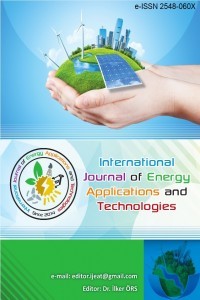Measurement of Energy Consumption of WSN for Indoor Environment
Measurement of Energy Consumption of WSN for Indoor Environment
WSN, Contiki OS, COOJA energy consumption, LEACH,
___
- Sindhwani, N., Vaid, R., 2013, “V LEACH: AN ENERGY EFFICIENT COMMUNICATION PROTOCOL FOR WSN”, Mechanica Confab, pp. 79-84.
- Rashid, B., Rehmani, M. H., 2016, “Applications of wireless sensor networks for urban areas: A survey”, Journal of Network and Computer Applications, pp. 192–219.
- Steiner, R. V., Lupu, E., 2016, “Attestation in Wireless Sensor Networks: A Survey”, ACM Computing Surveys, Vol. 49, No. 3, Article 51.
- Pridhi, Dr. R. G., 2016, “Energy Need Minimization by Power Aware Routing in WSN”.
- Yick, J., Mukherjee, B., Ghosal, D., 2008, “Wireless sensor network survey”, Computer Networks, pp. 2292–2330.
- Heinzelman, W. B., Chandrakasan, A., Balakrishnan, H., 2000, “Energy-Efficient Communication Protocol for Wireless Microsensor Networks”, Proceedings of the Hawaii International Conference on System Sciences, January 4-7, Maui, Hawaii.
- Katiyar, V., Chand, N., Gautam, G. C., Kumar, A., 2011, “Improvement in LEACH Protocol for Large-scale Wireless Sensor Networks”, PROCEEDINGS OF ICETECT 2011, 23-24 March, pp. 1070-1075, Nagercoil, India.
- Malik, M., Singh, Dr. Y., Arora, A., 2013, “Analysis of LEACH Protocol in Wireless Sensor Networks”, International Journal of Advanced Research in Computer Science and Software Engineering.
- Liao, Q., Zhu, H., 2013, “An Energy Balanced Clustering Algorithm Based on LEACH Protocol”, Proceedings of the 2nd International Conference On Systems Engineering and Modeling (ICSEM-13), Paris, France.
- Dunkels, A., Grönvall, B., Voigt, T., 2004, “Contiki - a Lightweight and Flexible Operating System for Tiny Networked Sensors”, Proceedings of the 29th Annual IEEE International Conference on Local Computer Networks (LCN’04), 16-18 Nov., Tampa, FL, USA.
- Osterlind, F., Dunkels, A., Eriksson, J., Finne, N., Voigt, T., 2006, “Cross-Level Sensor Network Simulation with COOJA”, 38th Annual IEEE Conference on Local Computer Networks (2006), Nov. 14-16, Tampa, FL.
- Akyildiz, I. F., Vuran, M. C., 2010, “Wireless Sensor Networks”, first edition, John Wiley & Sons Ltd, The Atrium, Southern Gate, Chichester, West Sussex, PO19 8SQ, United Kingdom.
- TEXAS INSTRUMENTS, “CC2538 Powerful Wireless Microcontroller System-On-Chip for 2.4-GHz IEEE 802.15.4, 6LoWPAN, and ZigBee® Applications”, DECEMBER 2012–REVISED APRIL 2015.
- Yayın Aralığı: Yılda 2 Sayı
- Başlangıç: 2014
- Yayıncı: İlker ÖRS
Cenker Aktemur, Islam Gusseinov
Measurement of Energy Consumption of WSN for Indoor Environment
Impact of Vehicle Hybridization on Fuel Consumption Economy
LAITH JAAFER AL-SAADY, Fouad A. Saleh, Bassim M. Maajel
Development of a household anaerobic digester for rural areas in Sudan
Hazir FAROUK, Mutaz ELOBAİD, Omer ABDELAZİM, Mohammed SALAH, Khalid BAKHEET, Andrew Lang
THE EFFECTS OF INCENTIVES ON RENEWABLE ENERGY RESOURCES FOR HOME USERS
